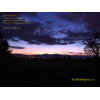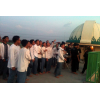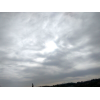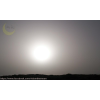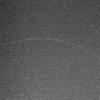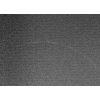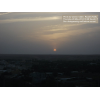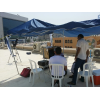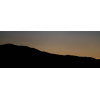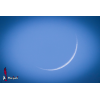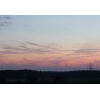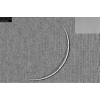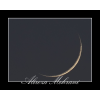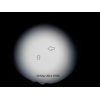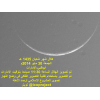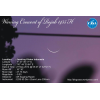Visibility of Sha'ban Crescent 1435 AH
- When to Observe Sha'ban Waxing (NEW) Crescent ?
- Sha'ban Waxing (NEW) Crescent Observation Results
- The OFFICIAL First Day in Different Countries
- When to Observe Rajab Waning (OLD) Crescent ?
- Rajab Waning (OLD) Crescent Observation Results
When to Observe Sha'ban Waxing (NEW) Crescent ?
The geocentric conjunction (Geocentric New Moon) will occur Inshalla on (Wednesday 28 May 2014) at 18:40 UT.
Sighting the new crescent on (Wednesday 28 May 2014) and (Thursday 29 May 2014) is shown in the below graphs using the program Accurate Times by Mohammad Odeh according to Odeh criterion. Where:-
- It is impossible to see the crescent from the areas located under the red color. Because either the Moon on this day sets before the Sunset and/or the topocentric conjunction occurs after the Sunset.
- The crescent is expected to be seen by optical aid only from the areas located under the blue color.
- The crescent is expected to be seen by optical aid from the areas located under the magenta color. In these areas the crescent could be seen by naked eye if the atmospheric conditions are superb and the observer is experienced.
- The crescent is expected to be easily visible by naked eye from the areas located under the green color.
- The crescent cannot be seen from uncolored areas, even though the Moon sets in these locations after the Sunset and the topocentric conjunction occurs before the Sunset, but the Moon is not sufficiently illuminated in order to be seen as crescent even by optical aid.
- Kindly notice that the below graph shows the possibility of seeing the crescent from areas between 60 degrees north of Equator down to 60 degrees south of Equator.
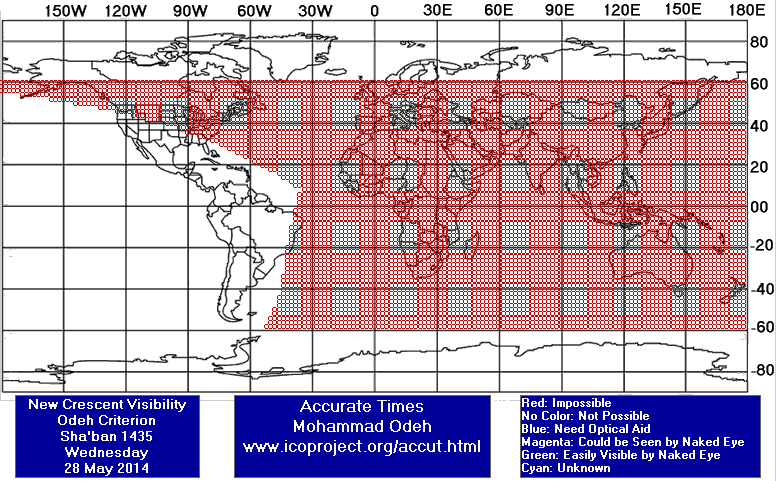

According to the Universal Hejric Calendar (UHC), which is based on the calculated crescent visibility, the start of this month in the Eastern Region will be on Saturday Friday 30 May 2014 and in the Western Region will be on Friday 30 May 2014. Kindly notice that the UHC is a pre-calculated calendar, which adopts a certain criterion to start the new Hejric month. Your country/organization might adopt different criterion to start the new Hejric month. So it is highly advised to read the UHC website before giving any judgment.
- Results of seeing the crescent, and the first day of the month in different countries will be added here Inshalla as we receive the reports from ICOP's members. If you wish to be a member in ICOP, or to know more about it, kindly click here.
Sha'ban Waxing (NEW) Crescent Observation Results
Thu 29 May 2014
Algeria
Mr. Hocine Chikh Aissa said: " 04 persons were prensent in N'tissa station. Sha'ban 1435 crescent was seen by binoculars (7*50)(25-45*60) and it is One of the tow record in this year 1435 for the club Ammi Said d'astronomy amateur. تحققت والحمد لله رؤية هلال شعبان 1435هـ من مدينة غرداية جنوب الجزائر في يوم الخميس 29 ماي 2014 في سماء صافية قلما نشاهد مثلها مع العلم أن مدينة غرداية تقع في حدود نهاية المنطقة الزهرية في خريطة إمكانية رؤية الهلال، وهذه والحمد لله المرة الثانية خلال هذه السنة تتحقق فيه رؤية هلال بهذه المعطيات بعد هلال صفر، الحاضرون في الرصد: الشيخ عيسى حسين الحاج موسى آدم الحاج سعيد صالح عمي سعيد موسى أعضاء في جمعية عمي سعيد لهواة الفلك غرداية - جنوب الجزائر فاللهم بارك لنا في شعبان وبلغنا رمضان، آمين "
France
Mr. Bilel DZ said: "تم رصد الهلال مساء يوم الخميس 29 مَايُو 2014 والحالة الجوية كانت مناسبة و السماء من جهة الغرب كانت غائمة جزئيا. رؤي الهلال بالمرقب* تمت الرؤية بالتحديد على الساعة 21:31 http://olmf.fr/toulon-chaabane-1435-2905-ar/"
Indonesia
Mr. AR Sugeng Riyadi said: "On Thursday, 29 May 2014; we are the students of CASA (Club Astronomi Santri Assalaam) from the Modern Boarding School of Islam ASSALAAM and some students from SMA Al-Islam 1 Surakarta Central Java Indonesia tried to observe the moon (Hilal) of Shaban 1435 AH at Assalaam Observatory. The wes horizozn was clear untill 17:05 pm, but the thick cloud was covered the west horizon before the Sun sets. The New Crescent of Shaban 1435 AH was NOT SEEN untill the moon sets. The first day of Shaban 1435 AH in Indonesia according to the government calendar will begin on Friday, 30 May 2014."
Iran
Mr. Hossein Janghorbani said: "Mr. Hossein Janghorbani said: "Mr. Hossein Janghorbani said: “In the name of God” Sha'ban Crescent Observation Report Astronomy and Geophysics Center of Shahreza – The Crescent Association of Shahreza Report by: Hossein Janghorbani (Najm-al-Sepehr) – Manager of Shahreza Crescent Association and Red Crescent’s Astronomy and Geophysics Center Date: Monday, 05/29/2014 Location: Damzad Mountaintop beside the historic Tower Senbandy in the East of Shahreza (latitude: 32 00 N, longitude: 51 52 E, elevation: 2325m from sea level, time zone: +4.5 GMT) Equipments: one sets of 15*70, one sets of 20*90 binoculars, one compass. Atmospheric condition: cloudy in western horizon. Horizon obstacles: 0° Apparent sunset: -- Actual sunset: 20:01 Results: The crescent moon was not seen because of the clouds in the western horizon. Observers:1.Sayed Mooslem rezvani 2.Sayed Farzad alavi 3.Hoosein janghorbani 4.Ali janghorbani 5.Reza janghorbani 6.Shakiba moslehi 7.Mohadeseh alinejad 8.Mahsa khajeh "
Iraq
Dr. AbdulSattar M. Khidhir said: "طيلة النهار كانت في السماء غيوم متقطعة وتم محاولة رؤية الهلال عدة مرات من خلال التلسكوب ولم نتمكن من ذلك رغم انه تم مشاهدة المريخ خلال فترة ما بعد العصر وبعد غروب الشمس كانت هناك غيوم كثيفة باتجاه الغرب ولم نتمكن من رؤيته"
Jordan
Libya
Eng. Mohammed Abdulkarim said: "كانت حالة الجو لا تسمح حتى برؤية الشمس ولهذا لم يتم رصد الهلال."
Saudi Arabia
Mr. Samy Khadem-Al-Charieh said: "Our team observed in Alfiqrah, which is near to Madinah. Atmospheric conditions was difficult, because there were cirrus clouds coming and going all the time."
Eng. Qamar Uddin said: "On Thursday 29 May 2014, I decided to join a group of astronomers & observers from Riyadh to look for the Shaban 1435 AH moon. They had both computerised optical and CCD camera based telescopes, but the cloudy/dusty western horizon did not allow us to see the crescent. The sun disappeared from the horizon well before the sunset time. We have not received news of actual sighting from any of the other groups in Saudi Arabia either. However, the month will start from tomorrow 30/5/2014 as per the Ummul Qura calendar. Please see the attached photo of the typical western horizon in Riyadh during the summer months."
Mr. Mecca Observatory Director said: "تمت رؤية الهلال باستخدام تقنية التصوير الفلكي من جبل الفقرة في منطقة المدينة المنورة الساعة 07:30 صباحا بتوقيت المملكة. تصوير مرصد المدينة التابع لمرصد مكة المكرمة"
South Africa
Dr. Abdurrazak Ebrahim said: "Cape Town unsatisfactory weather conditions resulted in a negative sighting"
Spain
Tanzania
Mr. Zaffar Sheriff said: "The Sha'baan crescent was not seen in Daressalaam. "
Tunisia
United Arab Emirates
Eng. Mohammad Odeh said: "حاولنا اليوم تحري هلال شهر شعبان من مدينة أبوظبي باستخدام تقنية التصوير الفلكي، وتكون فريق الرصد من ستة أشخاص وهم تركي العمري وبندر العمري ومحمد العمري وفراس سبيتي ومحمود علوان ومحمد عودة. بدأنا الاستعداد للرصد الساعة 12:30 ظهرا، وكانت درجة الحرارة عالية جدا حيث وصلت يوم أمس إلى 45 واليوم أكثر من 43، وأدت درجة الحرارة العالية لعدم عمل بعض الأجهزة، حيث كان جهاز الحاسوب يفصل بشكل تلقائي عدة مرات، مما أخر عملة الرصد كما أنه أخر عملية البث المباشر لحوالي ساعتين، بعد ذلك تمكنا من تشغيل جهاز الحاسوب بصعوبة بتسليط مروحة كبيرة على جهاز الحاسوب، وبدأنا بعدها بالرصد بحدود الساعة الثالثة عصرا وبقينا في محاولات مستمرة حتى موعد غروب القمر في الساعة 19:43، وكانت السماء خالية من الغيوم ولكن كانت مغبرة بشكل واضح، حيث كانت قيمة صفاء الغلاف الجوي TOD تساوي 0.8 وهذه قيمة تلوث جوي كبيرة مما أعاق رؤية الهلال حتى باستخدام تقنية التصوير الفلكي التي استمرت حتى موعد غروب القمر. "
United States
Dr. Javad Torabinejad said: "It was cloudy and foggy here in Blacksburg, VA; the following report is for a sighting by Mr. Jim Lockyer of Wildomar, CA. The photos were taken between 8:45 pm to 9:00 pm PDT before the crescent set over the Santa Ana Mountains. The moon was not visible until around 8:35 pm (sunset: 7:51 pm). I was using binoculars to locate the moon but it only came into view around the 8:35 time. It was faintly visible to the naked eye if you knew where to look, and had you not been looking for it you would not have seen it. There was a lot of particulate matter in the air as well. In a nearby station (Murrieta/temecula French Vall; ~10 miles away), at 8:35 pm, the temperature, dew point, and relative humidity were 20.0 C, 11.0 C, and 56%, respectively."
Fri 30 May 2014
Bahrain
Germany
Eng. Martin Elsaesser said: "Clouds had prevented me from observing the crescent yesterday and this day also started with a solid cloud cover. Two hours before sunset a short gap appeared (as predicted from the satellite images) and i could easily capture the crescent in the bright skies despite the sun and remaining haze. The software automatically adapted to the quick changes in cloud cover and made it possible to use this short opportunity for daytime observation. After sunset the sky had cleared again in the west so that the crescent could then be seen easily with the naked eye. "
Iran
Iraq
Dr. AbdulSattar M. Khidhir said: "تمت محاولة رؤية الهلال بوساطة التلسكوب خلا فترة النهار ولم نتمكن من رؤيته لغاية الساعة السابعة وستة دقائق أي قبل غروب الشمس بحوالي 10 دقائق بعد ذلك بحدود 5 دقائق تمت رؤية الهلال بالعين المجردة أي قبل الغروب بخمسة دقائق "
Tunisia
United Arab Emirates
Eng. Mohammad Odeh said: "بدأنا الرصد بحدود الساعة 11 ظهرا تكون فريق الرصد اليوم من أربعة أشخاص وهم تركي العمري وبندر العمري ومحمد العمري ومحمد عودة. الغلاف الجوي كان نقي بشكل استثنائي بالنسبة لمدينة أبوظبي، حبث كانت قيمة الـ TOD تساوي 0.37 وكانت قيمة الـ AOD تساوي 0.23 وهذه قيم نادر ما تكون في أبوظبي. رأينا الهلال بكل سهولة باستخدام تقنية التصوير الفلكي. "
The OFFICIAL First Day in Different Countries
Fri 30 May 2014
1 . Algeria
2 . Bahrain
3 . Egypt
4 . France
5 . Indonesia
6 . Iran
7 . Iraq
8 . Kuwait
9 . Libya
10 . Morocco
11 . Oman
12 . Qatar
13 . Saudi Arabia
14 . Tunisia
15 . United Arab Emirates
16 . Yemen
Sat 31 May 2014
1 . Pakistan
2 . South Africa
3 . Spain
When to Observe Rajab Waning (OLD) Crescent ?
The geocentric conjunction (Geocentric New Moon) will occur Inshalla on ( Wednesday 28 May 2014 ) at 18:40 UT.
Sighting the OLD crescent on ( Wednesday 28 May 2014 ) and on ( Tuesday 27 May 2014 ) is shown in the below graphs using the program Accurate Times by Mohammad Odeh according to Odeh criterion. Where:-
- It is impossible to see the OLD crescent from the areas located under the red color. Because either the Moon on this day rises after the Sunrise and/or the topocentric conjunction occurs before the Sunrise.
- The crescent is expected to be seen by optical aid only from the areas located under the blue color.
- The crescent is expected to be seen by optical aid from the areas located under the magenta color.. In these areas the crescent could be seen by naked eye if the atmospheric conditions are superb and the observer is experienced.
- The crescent is expected to be easily visible by naked eye from the areas located under the green color.
- The crescent cannot be seen from uncolored areas, even though the Moon rises in these locations before the Sunrise and the topocentric conjunction occurs after the Sunrise, but the Moon is not sufficiently illuminated in order to be seen as crescent even by optical aid.
- Kindly notice that the below graph shows the possibility of seeing the crescent from areas between 60 degrees north of Equator down to 60 degrees south of Equator.
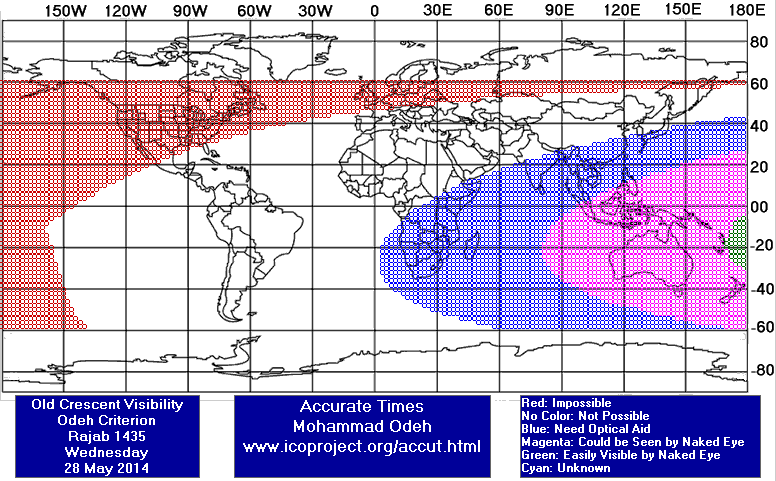
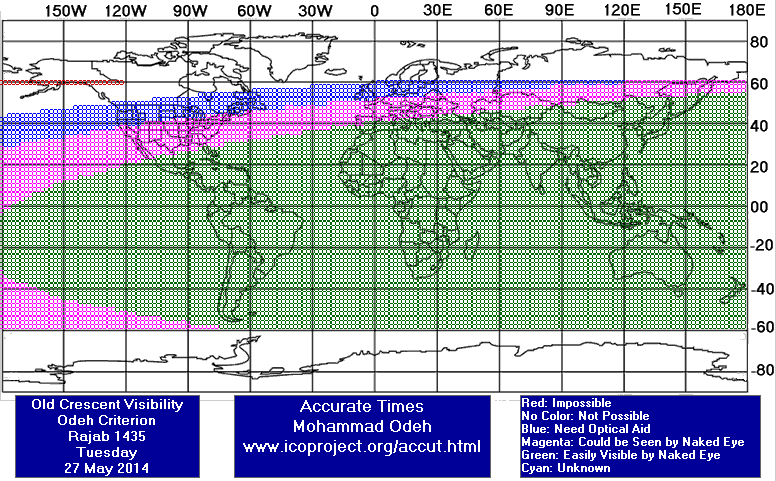
Rajab Waning (OLD) Crescent Observation Results
Tue 27 May 2014
Indonesia
Mr. AR Sugeng Riyadi said: "On Tuesday, 27 May 2014 the old crescent of Rojab 1435 H was easy seen from my personal observatory at Bendo Ketitang Juwiring Klaten Central Java Indonesia."
Iran
Wed 28 May 2014
Indonesia
Mr. AR Sugeng Riyadi said: "On Wednesday, 28 May 2014 the old crescent of Rojab 1435 AH was NOT SEEN from Assalaam Observatory Pabelan Kartasura Sukoharjo Central Java Indonesia, because the east horizon was cloudy."

